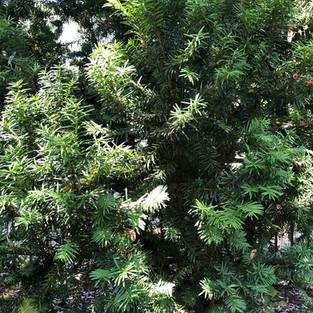"If there is a bustle in your hedgerow, don't be alarmed now."

When it comes to hedges, boxwoods (Buxus), English cherry laurel (Prunus laurocerasus), privet (Ligustrum vulgare), Japanese hollies (Ilex crenata) and yews (Taxus media) prevail across the Chesapeake watershed.
Shrubs like boxwood, English cherry laurel and yews, above, are evergreen and, with the exception of boxwood blight, strong growers, making them popular with nurseries, landscapers and most of us. While these shrubs provide nesting habitat, they don't support the full life cycle of caterpillars, other insects and birds. Hedges can take up a lot of your garden space so, from an ecological standpoint, they are a golden opportunity to add to our collective habitat if you can make a native selection.
Since evergreen hedges are so desirable, let's start there. To my mind, there is one almost perfect substitute for the ornamental non-native evergreen hedges. It's inkberry (Ilex glabra). Inkberry grows in sun or part shade in medium to moist soils and is a rounded evergreen shrub with leaves similar in shape and color to boxwood. Inkberry is less dense than boxwood. Shrubs can be pruned as individual plants or grown together in a formal hedge shape.

They are green year round and female shrubs have tiny white flowers in spring that form dark berries
Like any evergreen shrub, it's essential to regularly water the first few years to get them established. During the summer, dry stretches can cause branches and leaves to turn dark brown. If this happens, it's essential to resume regular watering until the plant is more established. Once established, watering typically isn't necessary. This can take several years.

The inkberries above are unpruned, allowed to do their own thing and have grown around a utility box just visible in the center of the photo. These could also be pruned into a more formal shape as below.

Inkberries can be pruned to any height or if left to grow, they will reach 6 to 8 feet. You will often read, or hear, that inkberries become too leggy meaning there is a lot of growth at the top but the lower stems become bare. This looks to be occurring in the photo above. This happens when you shear the top of the shrub to create a straight line.
Wherever a plant is cut, that is where new growth will emerge. So, if you shear a shrub continually, it will push its new growth from where that cutting occurred, at the top or side, rather than from within the shrub. To avoid this, use "selective pruning." Selective pruning means you randomly cut the tallest stems about a third down, above a branch fork or pair of leaves. This will stimulate new growth from within the body of the shrub where the legginess is occurring. You can use this method to achieve any height or shape you desire.
If your hedge doesn't need to stay green all year, there are many other interesting deciduous native alternatives that come alive in spring and fall with gorgeous color. Fothergilla (Fothergilla major) is one to choose if the opportunity arose. A hedge of these phenomenal flowers says spring is here with an exclamation point. In fall, oranges and red punctuate the landscape again. These also grow in medium to moist soil to 6 to 8 feet in height.
The fothergilla hedge above is blooming despite being sheared, which inevitably removes a number of flowers. This hedge in full sun will be spectacular come fall. These photos of hedges are of plantings at Washington DC apartment complexes demonstrating they are fairly low maintenance once established.
Why talk about hedges now? Early fall is a great time to plant a new hedge. Temperatures are cooler and plants have time to get roots established before winter sets in. Hedges also require plants in numbers, so there is time to plan and call your favorite nursery to ask for plants you may need, or talk to a landscaper who will have to do the same.

The Led Zeppelin lyrics "If there's a bustle in your hedgerow, don't be alarmed now" in "Stairway to Heaven" was my first introduction to the term 'hedgerow.' Hedgerows are definitely the new "it" hedge. Typically a 5 to 10 foot wide linear planting, hedgerows are a mix of native trees, shrubs and grasses used to enclose property boundaries and were used as some of the first 'fences' to contain livestock. They are coming back in vogue because of the immensely superior habitat they provide in comparison to a fence or single plant hedge. The best part is you don't have to choose just one shrub, you can choose many. At the top of the charts for my ideal hedgerow would be native viburnum (Viburnum nudum) for spring flowers, summer berries and fall color, fothergilla for spring flowers and fall color, winterberry (Ilex verticillata) for winter color, inkberry for evergreen color and red chokeberry (Aronia arbutifolia) for spring flowers, summer berries and fall color.
If you were hedging your bets, the hedgerow is the best way to go! A bustle in your hedgerow is certainly no need for alarm, as they are designed to provide habitat. Led Zeppelin was right on point!

























Comments